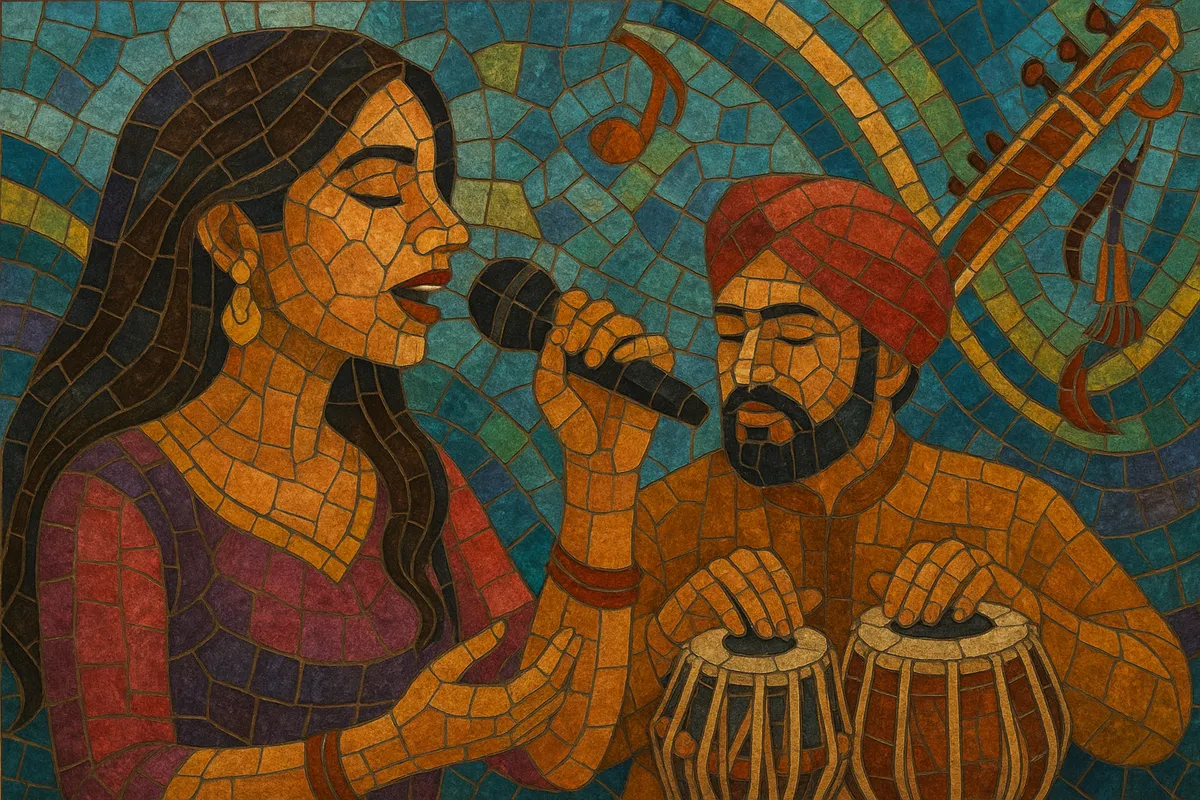Your digger level
0/5
🏆
Sign in, then listen to this genre to level up
Description
Desi pop is a broad umbrella of South Asian popular music that blends Western pop songwriting and production with Indian, Pakistani, Bangladeshi and diasporic sensibilities.
It foregrounds catchy melodies, verse–pre-chorus–chorus structures, and contemporary electronic production while borrowing vocal ornamentation, rhythms, and instruments from regional traditions (e.g., Punjabi dhol, tumbi, tabla, sitar).
Lyrics commonly mix Hindi/Urdu/Punjabi (often with Hinglish), and themes range from romance and nostalgia to dancefloor celebration. The sound spans glossy dance‑pop, R&B‑tinged ballads, and bhangra‑inflected club tracks, often overlapping with Bollywood but existing independently of film.
History
Origins (1980s)
• The modern idea of South Asian “pop” coalesced in the early 1980s, led by Pakistani pioneers such as Nazia & Zoheb Hassan. Their breakthrough album Disco Deewane (1981) demonstrated that non‑film, youth‑oriented pop in South Asia could rival film songs in reach. Parallelly, independent pop singles began appearing in India, seeding a non‑filmi market.
Indi-pop boom and TV era (1990s)
• Cable TV channels and music video culture (e.g., MTV/Channel V) fueled a massive Indi‑pop wave in India. Artists like Alisha Chinai, Falguni Pathak, Lucky Ali, Euphoria, Colonial Cousins, and Bombay Vikings popularized slick, radio‑friendly pop outside of cinema. Bhangra‑pop (Daler Mehndi and others) brought Punjabi rhythms into mainstream pop.
• In Pakistan, acts such as Vital Signs, Strings, and later Atif Aslam pushed a parallel pop/soft‑rock line that crossed over regionally.
Diaspora crossover (late 1990s–2000s)
• British‑Asian and North American artists fused R&B, hip hop, and bhangra with South Asian hooks, creating a recognizably "desi pop" crossover for global audiences. Jay Sean, Raghav, RDB, and Juggy D helped normalize Hinglish lyrics, Western toplines, and club‑leaning production for international radio.
Streaming era and Bollywood convergence (2010s–present)
• YouTube, TikTok/shorts, and DSP playlists blurred lines between independent desi pop and Bollywood. Pop aesthetics increasingly inform film soundtracks, while standalone singles by singers such as Armaan Malik, Shirley Setia, and Neha Kakkar dominate charts.
• Collaborations with global producers and the rise of desi hip hop/R&B further diversified the sound, keeping the genre club‑ready yet rooted in South Asian melody and rhythm.
How to make a track in this genre
Song form and harmony
• Use a pop structure (intro–verse–pre‑chorus–chorus–verse–chorus–bridge–final chorus). Keep choruses hooky and concise.
• Harmony typically stays diatonic with bright, radio‑friendly progressions (e.g., I–V–vi–IV), occasionally tinted by raga‑like modal color tones.
Melody and vocals
• Write singable toplines with memorable refrains; employ melismas, meend (glides), and light murki (ornaments) to add South Asian character.
• Alternate Hindi/Urdu/Punjabi lines with English (Hinglish) for modern appeal. Keep syllables rhythmically tight in choruses.
Rhythm and groove
• For dance‑leaning tracks, target 90–110 BPM (R&B/hip‑hop swing) or 115–128 BPM (dance‑pop/house feel).
• Blend Western drums (kick/snare/hi‑hat patterns, 4‑on‑the‑floor or trap hats) with regional grooves (keherwa 8‑beat, dadra 6‑beat; bhangra chaal accents). Layer dhol for big drops and handclaps for crowd energy.
Instrumentation and sound design
• Core: pop synths, pads, bass (sub + mid), guitar/piano, modern drum kits.
• Desi colors: dhol, tumbi, tabla, dholak, sitar/surbahar phrases, bansuri licks, harmonium chords. Use these as hooks or fills rather than dense layers to keep the mix contemporary.
• Production: crisp vocals upfront, sidechain pads to kick, widen chorus elements, and reserve folk instruments for intro/hooks/turnarounds for maximum impact.
Lyrics and themes
• Center on love, longing, celebration, and youthful nostalgia. Keep imagery accessible and relatable; lean into call‑and‑response and slogan‑like refrains for crowd sing‑alongs.
Arrangement tips
• Tease the hook in the intro, strip down for verses, lift energy in pre‑chorus, and deliver a full‑band chorus. Consider a rap/sung bridge or a half‑time drop to refresh the final refrain.


